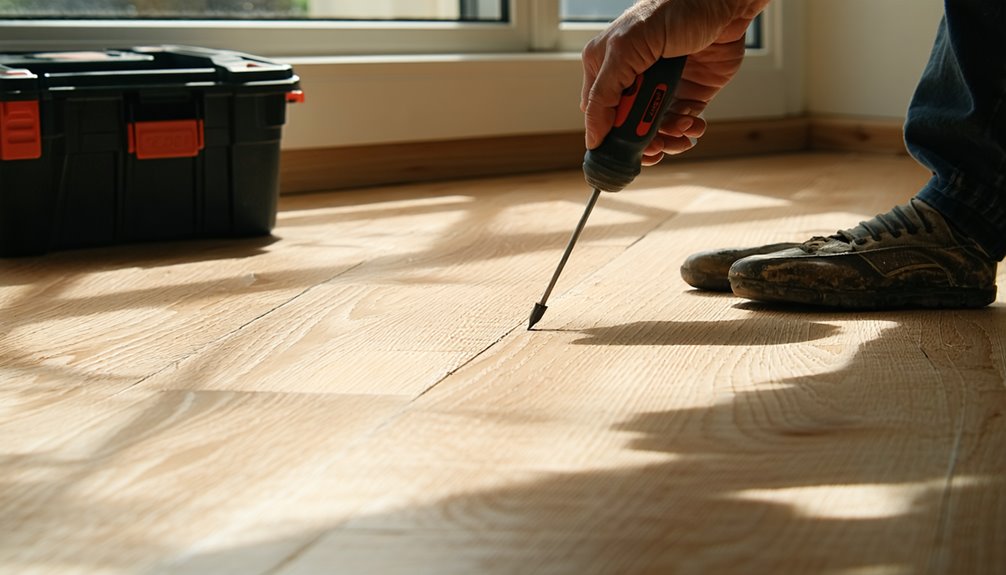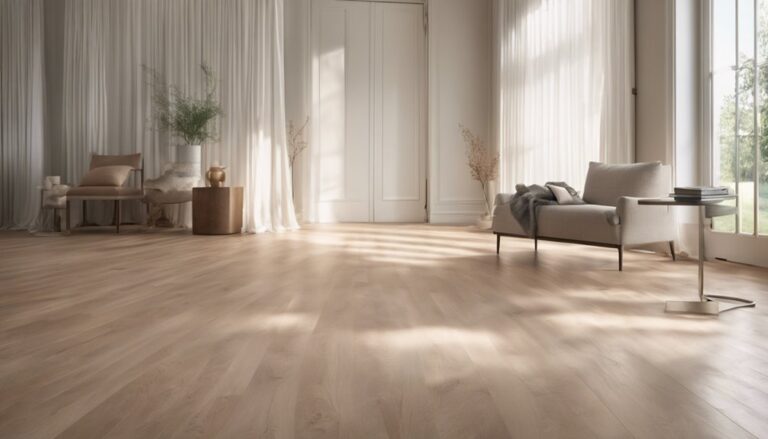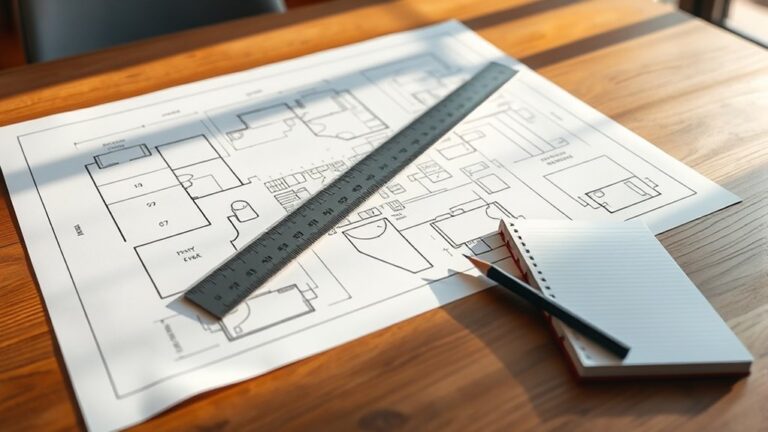To fix squeaky floors, start by identifying the source of the noise. You can use talcum powder or silicone-based lubricants to reduce friction. Tighten loose floorboards using screws or nails, and reflect on applying wood glue in gaps for added stability. Inserting shims between joists can help eliminate movement. Squeak-stopper kits are also effective and easy to install. Adding carpets or rugs not only dampens noise but enhances comfort. If the problem persists, you might want to reflect on seeking professional help for a thorough assessment and lasting solutions. There's plenty more you can do to tackle this issue effectively.
Identify the Source of Squeaks
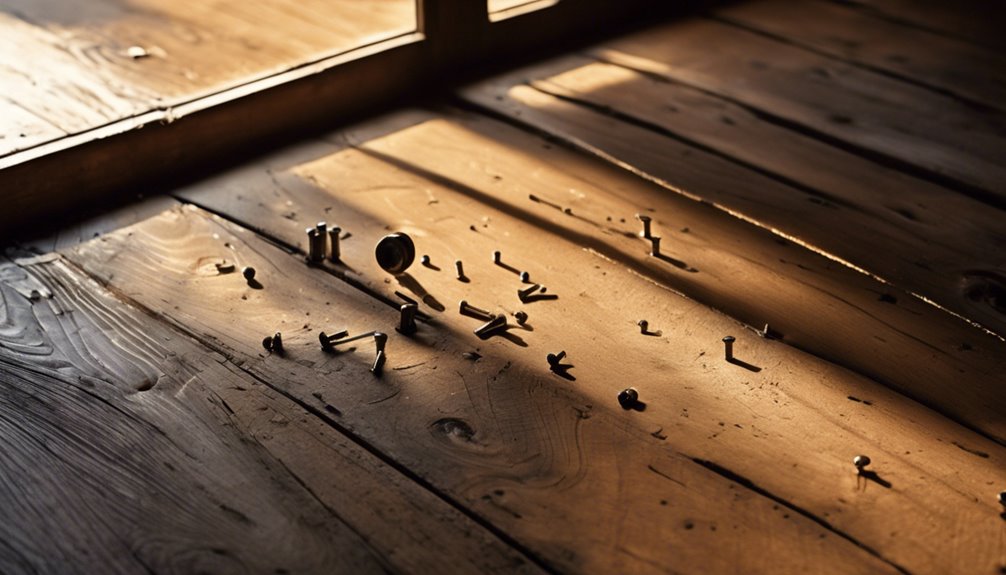
Have you ever wondered why your floors squeak? Identifying the source of these pesky noises can be the first step toward reclaiming peace in your home. Common squeak causes include loose floorboards, uneven subflooring, or worn-out fasteners. Different floor materials, like hardwood, laminate, or carpet, can exacerbate these issues. For instance, hardwood tends to expand and contract with moisture changes, leading to squeaks as the boards rub against each other. If you've got carpet, the padding beneath may shift, causing movement and noise when walked on. By pinpointing the specific cause, you can take effective action to silence those squeaks. Understanding your floor's materials and their behaviors will empower you to maintain a quieter, more comfortable living space.
Use Talcum Powder or Lubricants
If your floors are still squeaking, using talcum powder or lubricants can help reduce the noise. Sprinkling talcum powder in the gaps can absorb moisture and create a smoother surface. Alternatively, applying lubricants to the joints can ease friction and eliminate those annoying sounds.
Talcum Powder Application
Although squeaky floors can be frustrating, a simple application of talcum powder or a silicone-based lubricant can often silence those annoying creaks. Start by sprinkling talcum powder generously between the floorboards, ensuring it gets into any gaps. The talcum powder benefits include reducing friction and absorbing moisture, which helps prevent further squeaking. If you'd like to explore talcum powder alternatives, consider using cornstarch or a commercial wood lubricant. Simply apply your chosen option in the same manner as talcum powder. After application, walk over the area to distribute the powder or lubricant evenly. This quick fix can make a significant difference in your home's comfort, allowing you to enjoy the freedom of a quieter space.
Lubricants for Joints
When it comes to addressing squeaky floors, using lubricants for the joints can be an effective solution. Different lubricant types, like silicone spray or graphite powder, work wonders in minimizing noise. Simply apply your chosen lubricant directly to the squeaky joint and let it seep into the crevices. This not only reduces friction but also promotes better joint maintenance. If you're looking for a quick fix, talcum powder can also serve as a temporary lubricant; just sprinkle it generously and sweep away the excess. Remember, regular maintenance is key to keeping those joints quiet and your floors feeling free. With a little effort, you can enjoy a peaceful, squeak-free home.
Tighten Floorboards and Fasteners
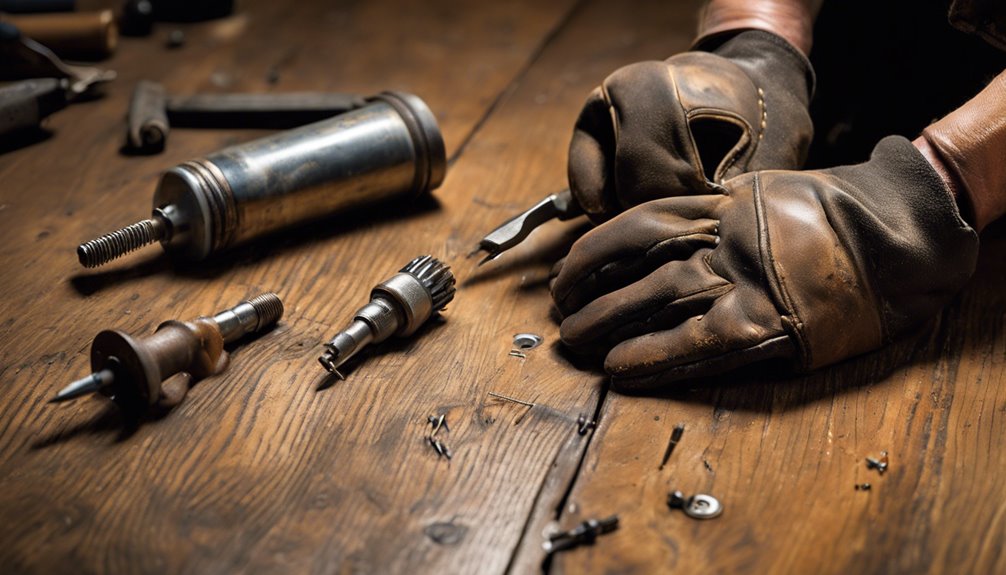
To fix your squeaky floors, start by identifying any loose floorboards that may be causing the noise. Once you've found them, use appropriate fasteners to secure the boards back in place, ensuring a tight fit. Don't forget to check for gaps that might need attention to prevent future squeaks.
Identify Loose Floorboards
One of the first steps in fixing squeaky floors is identifying loose floorboards. Start by walking around your space, listening for those pesky squeaks. Pay attention to the types of floorboard materials you have—be it hardwood, laminate, or engineered wood. Each material can react differently, so knowing what you're working with helps. When you find a squeaky spot, gently press down to see if it shifts. This'll help you pinpoint which floorboards are loose. You might also want to check for gaps between the boards and the subfloor. Once you've identified the problem areas, you can move on to tightening them up, ensuring a more stable and quieter floor.
Use Appropriate Fasteners
Since you've pinpointed the loose floorboards, it's time to secure them with the right fasteners. Start by choosing appropriate fastener types—screws work best for durability, while nails can also do the job if you prefer a quicker option. Using screws, make certain you pick ones long enough to grip the joists beneath. When you're ready to install, first drill a pilot hole to prevent splitting the wood, then drive in the screws with steady pressure. For nails, a hammer will suffice, but be cautious not to overdrive them as that can lead to more squeaks. Proper installation techniques not only tighten those boards but also help maintain the integrity of your flooring, giving you that satisfying freedom from annoying squeaks.
Check for Gaps
After securing your floorboards, the next step involves checking for any gaps that could contribute to squeaks. Gaps between floorboards or between the boards and the subfloor can create friction, leading to noise. To tackle this, first, inspect the floor for any visible spaces. If you find gaps, consider using wood filler or shims to fill them. Tightening fasteners can also help minimize movement, enhancing overall floor maintenance. Make certain to retighten screws or nails that may have loosened over time. This attention to detail not only aids in noise reduction but also prolongs the lifespan of your flooring. By addressing gaps effectively, you'll guarantee a quieter and more comfortable living space.
Install Squeak-Stopper Kits
If you're tired of the constant creaking underfoot, installing squeak-stopper kits can be a straightforward solution. These kits offer several benefits that can enhance your living space and bring peace of mind. The installation process is generally simple, making it accessible even for DIY enthusiasts.
- Reduces noise and enhances comfort
- Increases the lifespan of your flooring
- Requires minimal tools and effort
- Affordable and effective option
Once you've gathered your materials, follow the instructions provided in the kit. You'll be amazed at how quickly you can eliminate those pesky squeaks. By investing a little time upfront, you can enjoy a quieter, more serene environment, allowing you to move freely without the distraction of floor noise.
Apply Wood Glue for Stability

To stabilize your squeaky floors, applying wood glue can be a highly effective method. Start by identifying the areas where the squeaks originate. Once you've pinpointed these spots, choose an appropriate wood glue type, such as PVA or polyurethane, known for their strong bonding capabilities. Using a caulking gun or a small applicator, apply the glue between the floorboards and any loose subflooring. Be careful not to overapply, as excess glue can create mess and complicate your flooring. Allow the glue to dry thoroughly, which will enhance floor stability and greatly reduce noise. This simple step not only fixes squeaks but also extends the life of your flooring, giving you the freedom to walk without worry.
Add Shims for Extra Support
While applying wood glue can help stabilize your floors, adding shims offers an additional layer of support that can effectively eliminate squeaks. Shims can bridge the gap between the joist and the floor, providing a snug fit. You'll need to choose the right shim materials, like wood or composite, to guarantee durability.
Here's how to approach shim installation:
- Identify the squeaky areas of the floor.
- Carefully lift the floorboards if needed.
- Insert shims to fill the gaps.
- Hammer them in gently for a tight fit.
Insulate Between Joists

Insulating between joists can greatly reduce floor squeaks by providing added support and stability. By using insulation materials like fiberglass or foam board, you can fill the gaps between the joists, minimizing movement and friction that causes those annoying sounds. These materials also enhance energy efficiency, keeping your home more comfortable.
In addition to insulation, consider implementing soundproofing techniques, such as adding resilient channels or acoustic panels, to further dampen noise. Make sure to install the insulation snugly, ensuring it doesn't sag or compress over time. This simple step not only addresses the squeaks but also contributes to a quieter, more peaceful living environment. Enjoy the freedom of a serene home without the distraction of squeaky floors!
Consider Carpet or Rugs
If you're looking for a quick and effective way to minimize squeaky floors, consider adding carpet or rugs to your living spaces. Not only do they provide a softer surface to walk on, but they also absorb sound, helping to reduce the noise from those pesky squeaks. Here are some carpet benefits and rug placement tips to keep in mind:
- Sound Dampening: Carpets and rugs can greatly muffle footsteps.
- Aesthetic Appeal: They enhance the visual appeal of any room.
- Comfort: A plush surface makes your space more inviting.
- Easy Maintenance: Rugs can be easily cleaned or replaced, allowing flexibility in design.
Seek Professional Help

Adding carpets or rugs is a great temporary solution, but sometimes squeaky floors require more than just surface-level fixes. If you've tried DIY methods and the noise persists, it might be time to seek professional help. Engaging professional services can save you time and frustration, as experts have the tools and experience to address the underlying issues effectively. They can provide expert advice tailored to your specific situation, ensuring the floorboards are properly secured and any structural problems are dealt with. Plus, they can help prevent further damage and potential safety hazards. Don't hesitate to reach out; sometimes, investing in professional assistance is the best way to regain peace and comfort in your home.
Frequently Asked Questions
Can I Prevent Squeaky Floors With Regular Maintenance?
Yes, you can prevent squeaky floors with regular maintenance. Start by checking for loose boards and securing them with nails or screws. Lubricating the floor joints with paraffin wax or talcum powder can also help with squeak prevention. Additionally, maintaining consistent humidity levels in your home can keep wood from expanding or contracting too much. Following these maintenance tips can keep your floors quiet and enhance your living space's comfort and freedom.
Will Humidity Affect My Floor's Squeaking?
Humidity levels can affect your floor's squeaking like a musician tuning an instrument. When humidity rises, some floor materials may expand, leading to increased friction and potential squeaks. Conversely, low humidity can cause materials to contract, which might also create noise. To minimize squeaking, aim for consistent humidity levels in your home. Maintaining a balanced environment helps keep your floors in harmony, allowing you to enjoy your space without annoying sounds.
Are Certain Types of Flooring More Prone to Squeaking?
Yes, certain types of flooring are more prone to squeaking. Hardwood floors often squeak due to their natural expansion and contraction with humidity changes. The type of subfloor and installation can also contribute. On the other hand, carpet can squeak when the padding shifts or if the carpet is poorly installed. If you're looking for a quieter option, consider these factors when choosing your flooring to minimize those annoying noises.
How Long Does It Take to Fix Squeaky Floors?
If you think fixing squeaky floors takes eons, think again! With the right squeak detection methods, you can tackle those pesky noises in just a few hours. Depending on the repair methods you choose, like adding screws or using lubricant, you could be enjoying a peaceful home in no time. So, grab your tools and get ready to reclaim your floor's serenity—freedom from squeaks is just a project away!
Can Pets Contribute to Floor Squeaks?
Yes, pets can definitely contribute to floor squeaks. Their behavior, like running or jumping, can put extra stress on certain flooring materials, causing them to shift or loosen over time. If your pet frequently plays in specific areas, you might notice more noise in those spots. To minimize this, consider using rugs or mats in high-traffic areas. Regular maintenance can also help keep your floors quieter, giving you peace of mind and more freedom to enjoy your space.

